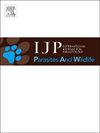欧亚海狸的水生原生动物和微孢子虫寄生虫(蓖麻纤维)
IF 2
3区 医学
Q3 ECOLOGY
International Journal for Parasitology-Parasites and Wildlife
Pub Date : 2025-02-27
DOI:10.1016/j.ijppaw.2025.101050
引用次数: 0
摘要
近几十年来,由于重新引入和自然种群增长,欧亚海狸(蓖麻纤维)在欧洲是一个不断扩大的物种。海狸在20世纪下半叶迅速扩张,它们在多瑙河流域的扩张尤其迅速。如今,大多数连续的人口分布在大陆的中部和东部,还有大量的不间断人口分布在挪威和瑞典。尽管海狸数量不断增加,但海狸作为水媒病原体来源的作用尚未得到牢固确立,或者通常是从间接数据中推断出来的。为了进一步了解发生在斯洛伐克的海狸寄生虫区系的组成,从三个地点(Topľa、Poprad和多瑙河流域)的洞穴附近采集了21份粪便样本,并通过显微镜和聚合酶链反应(PCR)进行了检查。pcr阳性标本进一步进行DNA测序检测。其中,隐孢子虫(2只)、囊虫(1只)、小孢子虫(1只)和脑孢子虫(1只)检出寄生虫。通过序列分析,分别鉴定出增殖隐孢子虫(1只)和脑孢子虫(1只)。一种新的囊虫亚型(ST)起源于多瑙河(斯洛伐克西南部)附近的一个地点,基于与最近描述的亚型ST12(11.9%)的高度遗传差异和在由ST的35-38组成的进化枝中的独特系统发育位置,提出了一种推定的新型囊虫亚型(ST)。人畜共患病传播或向其他动物传播的风险增加在Topľa河(斯洛伐克东北部)附近的地点尤为明显,在那里发现了人兽共患病基因D型的比氏肠内绦虫和肠内肠内绦虫的真菌孢子,以及潜在的人畜共患病的增殖梭菌卵囊。本文章由计算机程序翻译,如有差异,请以英文原文为准。

Waterborne protozoan and microsporidian parasites in Eurasian beavers (Castor fiber)
The Eurasian beaver (Castor fiber) is an expanding species in Europe in recent decades due to reintroductions and natural population growth. Beavers expanded rapidly in the second half of the 20th century, and their expansion was particularly rapid in the Danube basin. Nowadays, the majority of the continuous population located in the central and eastern parts of the continent and a large disjunct population in Norway and Sweden. Despite the increasing population size, the role of the beaver as a source of waterborne pathogens is not firmly established or is often inferred from circumstantial data. In order to extend knowledge about the composition of the parasite fauna of beavers occurring in Slovakia, 21 faecal samples taken near their burrows from three sites (located in the Topľa, Poprad and Danube river basin) were examined microscopically and by polymerase chain reaction (PCR). PCR-positive specimens were further examined by DNA sequencing. Parasites were detected in 21% of the examined beavers, specifically the protozoa Cryptosporidium spp. (n = 2), Blastocystis sp. (n = 1), and microsporidia Enterocytozoon bieneusi (n = 1) and Encephalitozoon spp. (n = 1). Using the sequence analysis, two variants of Cryptosporidium proliferans, a new subtype of Blastocystis sp., genotype D of E. bieneusi and Encephalitozoon intestinalis were identified. A putatively novel Blastocystis subtype (ST), originated from a site near the Danube river (southwestern Slovakia), was proposed based on high genetic divergence from the closest described subtype ST12 (11.9%) and unique phylogenetic position in a clade composed of ST's 35–38. The increased risk of zoonotic transmission or transmission to other animals was particularly evident in the site near the Topľa river (northeastern Slovakia), where fungal spores of zoonotic genotype D of E. bieneusi and E. intestinalis, together with oocysts of the potentially zoonotic C. proliferans, were found.
求助全文
通过发布文献求助,成功后即可免费获取论文全文。
去求助
来源期刊

International Journal for Parasitology-Parasites and Wildlife
Medicine-Infectious Diseases
CiteScore
3.80
自引率
5.60%
发文量
113
审稿时长
45 days
期刊介绍:
The International Journal for Parasitology: Parasites and Wildlife (IJP-PAW) publishes the results of original research on parasites of all wildlife, invertebrate and vertebrate. This includes free-ranging, wild populations, as well as captive wildlife, semi-domesticated species (e.g. reindeer) and farmed populations of recently domesticated or wild-captured species (e.g. cultured fishes). Articles on all aspects of wildlife parasitology are welcomed including taxonomy, biodiversity and distribution, ecology and epidemiology, population biology and host-parasite relationships. The impact of parasites on the health and conservation of wildlife is seen as an important area covered by the journal especially the potential role of environmental factors, for example climate. Also important to the journal is ''one health'' and the nature of interactions between wildlife, people and domestic animals, including disease emergence and zoonoses.
 求助内容:
求助内容: 应助结果提醒方式:
应助结果提醒方式:


